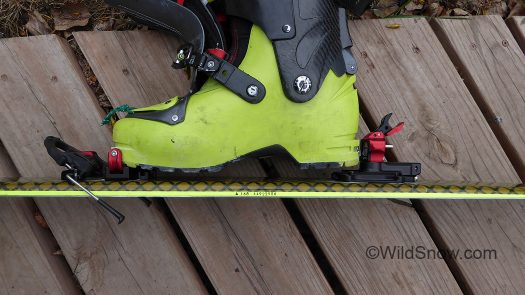
We’ve got our own special set of ATK jewelry here at WildSnow. I keep it in our floor safe and bring it out for special occasions; blog posts, for example. The test rig, a pair of Scott Super Guide 88 skis with my trusty TLT6ers. Can you spot what’s going on here? The binding heel unit is rotated 180 degrees to allow a super nice heel-flat-on-ski mode. Excellent for those long flat approach marches.
ATK. The unobtainable can be so attractive… But wait, you can indeed shop for some ATK ski touring bindings here in the U.S., as Hagan imports and re-badges selected models. For the purposes of this review, Hagan will indeed be importing the Raider 12 2.0, which they’ll call the “Core.”
Several things set ATK apart. The Raider ski brake is clever and clearly the lightest of any solution. Aesthetics and obvious quality of the aluminum construction inspire confidence. Heel lift in touring mode varies from flat to quite steep. ATK’s race inspired culture and fascinating variety (something like 12 tech binding models) tell you they’re serious about bringing you technology from the heart of Italy.
Price sets ATK (Hagan) apart as well. We’re talking retail that can easily be several hundred dollars more than similar bindings from other brands. Where you go with that is of course up to you, dear reader. Main thing, these grabbers will not disappoint.
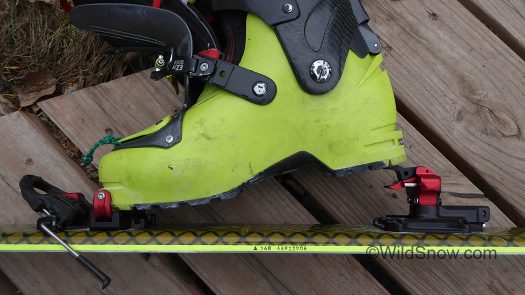
The heel lifters provide full 5 height options, high lift pictured here, heel flat on ski is obtained by rotating heel unit 180 degrees so the spring prongs are facing to the rear. With the heel in the rotated position you have an extra tall high-lift.
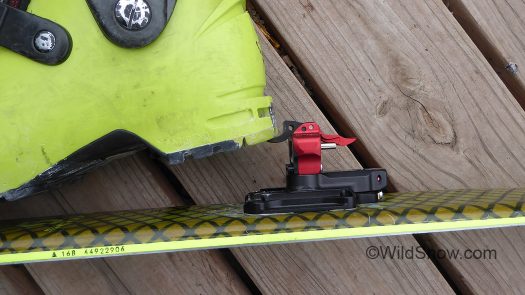
Heel unit rotated, using the medium lifter.
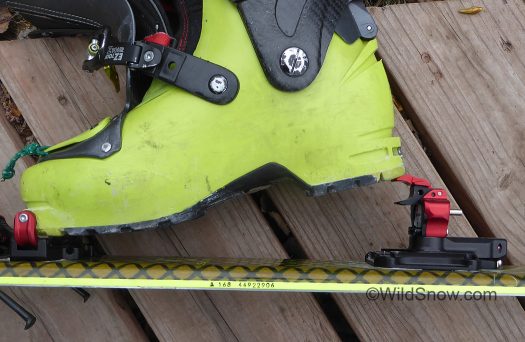
Stratospheric heel lift.
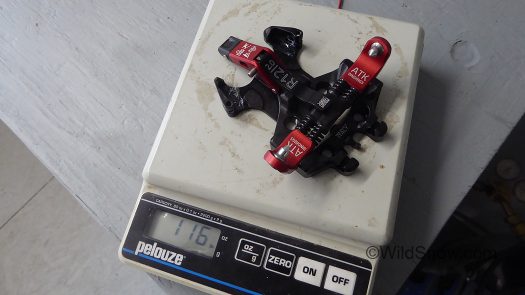
ATK Raider 12 toe unit with brake removed. Note this binding is clearly intended to be used with brake installed, as you otherwise have ugly vestigial parts adding weight with no purpose. That said, if you like the Raider heel lifter options but don’t like the brakes you can indeed run without them. Further, if you never want brakes but like the lifters, the Haute Route 2.0 binding is your choice as it combines a Raider heel with brakeless toe.
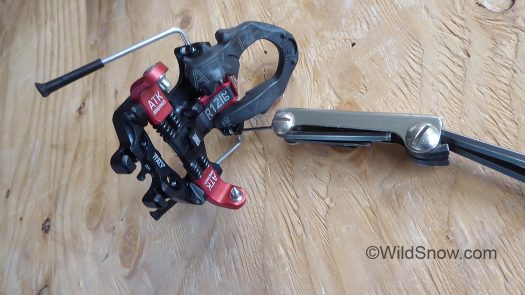
The brakes are a bit tricky to remove and install, yet nothing radical. You back out a couple of socket head studs with a metric hex driver, pull the brake out. Installing the brake requires a bit of fiddling with the springs. Leave on brake installed so you have a reference. It’s here I should say that while the ATK brake arms are stronger than they look, the deployment springs are not robust and are obviously designed for lighter weight skis. I’d advise caution if you expect a set of these to stop a pair of 120 mm wide fatties when you throw a shoe on piste.
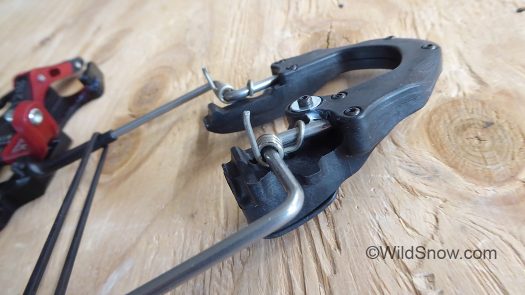
Brake deployment pressure springs. I like their minimalist nature but they’re not exactly robust.
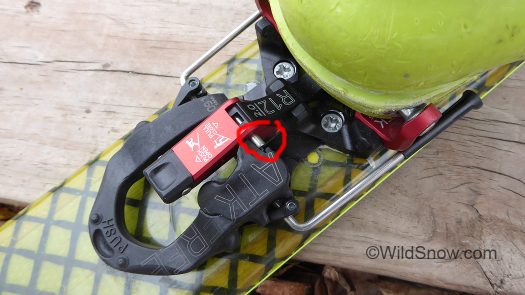
Brake stowage is ingenious. You simply press down on the black yoke, causing a pin (circled) to pop out and hold the brake up. Click. Exiting the binding (during either a safety release or by pressing down the touring lock lever) deploys the brake arms. IN OTHER WORDS this brake avoids the engineering cost of attempting to make it “automatically” stow when the user enters the binding or rotates the heel unit. My favorite ski brake remains the entirely independent type, such as that introduced by another major brand this season, but the ATK effort is top notch as well.
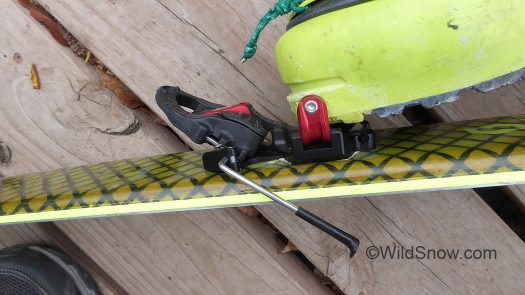
What’s nice is that the brake arms remain down as you enter the binding, thus keeping your ski secure on the snow. After you’re in, you stow the brake.
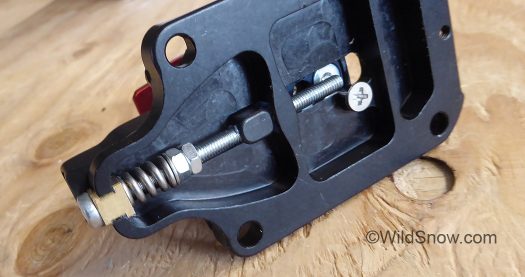
Underside of the heel unit demonstrates intelligent minimalism. You get fully three centimeters of boot length adjustment, along with a shock absorption spring. The Raider requires a 4mm heel gap. While the gap provides enough room for the ski to flex in most situations, it is wise having a spring for a little extra give in case things bind up.
What else? This is not a “U-spring” tech binding — it instead boasts independent vertical and lateral retention adjustments. I did a couple of moderate test climbs without locking toe; indicating that the toe unit springs are strong. The heel lifters flip easily, they’re held in place with small hidden magnets (more cleverness from Modena). Crampon slots appear strong, though they were tight and required slightly easing the shape of our crampon attachment axles. ATK claims they “improved the hooking geometry via their Easy-Entry System,” meaning the binding is easier to close on your boot toe when you step in. While I’ve tested other ATKs over the years I don’t remember a problem with that, so let’s just say it’s a wash.
Of more interest on the subject of binding entry, ATK also claims they provide an “ultra soft” step in at the heel. Any long-term user of tech bindings knows the problem. You’re putting your skis on in a powder field, you stomp your heel down, and your ski tail just digs a hole to Calcutta. Frustrating. I messed around with this quite a bit and honestly couldn’t feel much difference if any, perhaps because I run fairly low settings anyhow. If you set release values at 10 or above, the “ultra soft” effect might be more pronounced.
Conclusion
My on snow testing revealed the only penalty you pay for this amazingly featured binding is the wallet igniting retail price. It’s amazing that ATK provides a ski brake, crampon slot, full lateral-vertical release adjustments, multiple heel lifts and spring loaded boot length adjustment at 372 grams. Only cons I can come up are that I’d like the brake to be 100% removable without leaving the extra metal appendages, and less boot ramp angle would be nice. On the other hand, we’re talking mere grams and the brake only takes minutes to remove once you’ve practiced. MORE, for 2017-2018 ATK will be selling their Haute Route 2.0 binding, an RT 2.0 without the brake. Yeah, I quibble. Raider12 2.0 is nice stuff — remember it’s available as ATK or the Hagan Core. For more, please see our ATK coverage from this past winter’s ISPO.
Specifications
Total weight one binding with brake and screws: 372 grams
Toe, no brake, no screws: 116 grams
Brake, 85 mm: 52 grams
Heel unit, no screws: 187 grams
Available brake widths: 86, 91, 97, 102, 108, 120
Boot length adjustment: 30 mm.
WildSnow.com publisher emeritus and founder Lou (Louis Dawson) has a 50+ years career in climbing, backcountry skiing and ski mountaineering. He was the first person in history to ski down all 54 Colorado 14,000-foot peaks, has authored numerous books about about backcountry skiing, and has skied from the summit of Denali in Alaska, North America’s highest mountain.
